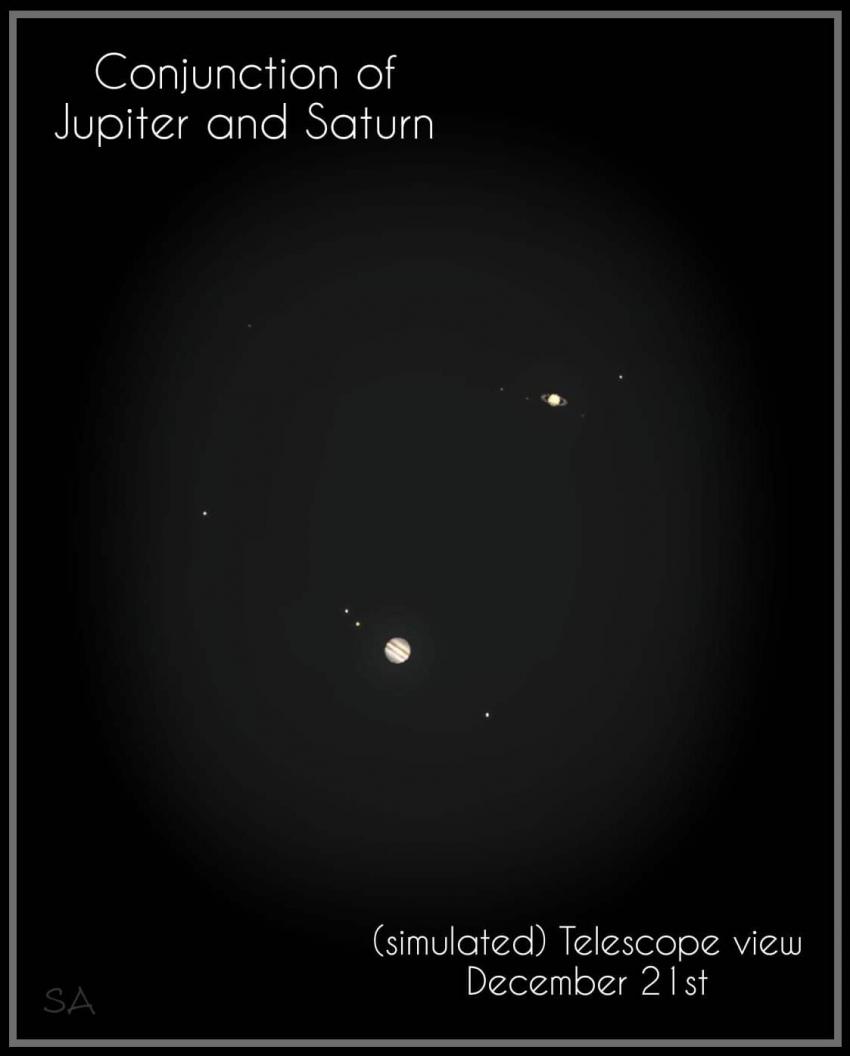On 21 December Jupiter and Saturn will appear closer together than at any time since the seventeenth century, in a rare ‘Great Conjunction’. The two largest planets in the Solar System will be just 0.1 degrees apart, or about one fifth of the diameter of the full Moon, and will be a spectacular sight in the south-western sky after sunset.
Conjunctions that are this close are very unusual, and Jupiter and Saturn were last seen in such close proximity in 1623. On that occasion, the two planets were close to the Sun in the sky, so would have been hard to pick out. The last time the planets were both this close and so easy to see was in 1226, long before the invention of the telescope.
As they move around the Sun, the planets often appear near to each other in the sky. Although they appear close together, this is only an optical effect: on 21 December Jupiter and Saturn will still be almost 800 million kilometres apart, despite appearing to be almost next to each other from the Earth’s perspective.
To see the two planets, look low in the south-west after sunset. As the sky darkens, first Jupiter and then Saturn will become visible. Both planets are bright – in the case of Jupiter brighter than all the stars – so will be obvious in a clear sky. By 1700 GMT both planets will be less than ten degrees above the horizon for UK observers, so it is important to find a line of sight without tall buildings or trees that will block the view.
With the eye, the pair will appear as two bright points of light. Binoculars will show those points as slightly larger dots: viewers may also be able to make out the four largest moons of Jupiter, and possibly Saturn’s largest moon Titan. With a small telescope the two planets will be in the same field of view, an exceptionally rare event, and the cloud belts on Jupiter and the rings of Saturn should be obvious.
The conjunction is entirely safe to view with the naked eye, although seeing Jupiter and Saturn will of course need a clear sky. If there is bad weather on 21 December, the good news is that the two planets only appear to move apart very slowly, and will still appear unusually close together on the days that follow.
Media contacts
Robert Massey
Royal Astronomical Society
Mob: +44 (0)7802 877699
press@ras.ac.uk
Morgan Hollis
Royal Astronomical Society
Mob: +44 (0)7802 877700
press@ras.ac.uk
Notes for editors
The Royal Astronomical Society (RAS), founded in 1820, encourages and promotes the study of astronomy, solar-system science, geophysics and closely related branches of science. The RAS organises scientific meetings, publishes international research and review journals, recognises outstanding achievements by the award of medals and prizes, maintains an extensive library, supports education through grants and outreach activities and represents UK astronomy nationally and internationally. Its more than 4,000 members (Fellows), a third based overseas, include scientific researchers in universities, observatories and laboratories as well as historians of astronomy and others.
The RAS accepts papers for its journals based on the principle of peer review, in which fellow experts on the editorial boards accept the paper as worth considering. The Society issues press releases based on a similar principle, but the organisations and scientists concerned have overall responsibility for their content.
In 2020 the RAS is 200 years old. The Society is celebrating its bicentennial anniversary with a series of events around the UK, including public lectures, exhibitions, an organ recital, a pop-up planetarium, and the culmination of the RAS 200: Sky & Earth project.
Follow the RAS on Twitter, Facebook, Instagram and YouTube
Download and subscribe to the RAS Supermassive Podcast


